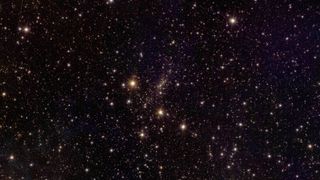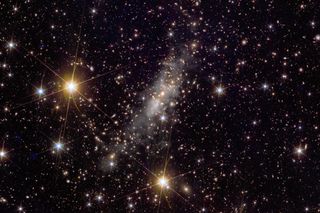By combining a new image of a giant galaxy cluster with older X-ray data, scientists from European Space Agency (ESA) have demonstrated how galaxies in the cluster are bathed in huge amounts of gas that can reach scorching temperatures of up to 100 million degrees Celsius (180 million degrees Fahrenheit).
The galaxy cluster, Abell 2390, was photographed recently by ESA Euclid Missiondesigned to study black matter And dark energy by probing gravitational lens occurrences in galaxy clusters. Because these clusters contain such a large mass — up to ten thousand billion solar masses value — they are able to fold the fabric of space–time The galaxies around them are distorted to such an extent that the light from distant galaxies in the background becomes extremely magnified. It’s as if you’re looking at them through a giant magnifying glass. If we zoom in on the core of Abell 2390, we see that the lensing effect is at its peak, stretching, distorting and amplifying the light from other galaxies billions of light-years away.
However, most of the mass of a galaxy cluster is not found in its galaxies. In fact, these galaxies contribute only about 5% of the cluster’s total mass. The largest contributors are the hot intra-cluster gas between the cluster’s galaxies, which makes up about 15% of the cluster’s mass, and invisible dark matter, which makes up 80% of Abell 2390’s mass.
Although we can infer the presence of dark matter from the degree of gravitational lensing, we cannot see it. We can, however, see the intra-cluster gas using ESA’s X-ray vision XMM-Newton mission that detected this gas in Abell 2390 in 2001.
Related: X-ray spacecraft reveals strange ‘cloverleaf’ radio circle in new light (image)
In this new composite view, we see Euclid’s image of Abell 2390, which lies 2.7 billion light-years away in the direction of the constellation PegasusThe Winged Horse. Euclid’s image is incredible; it is a very wide-field image, the field of view through his 1.2-meter (3.9-foot) aperture telescope spanning 1.25 by 0.73 square degrees. The image encompasses some 50,000 galaxies, many of which are not actually in Abell 2390, which is visible in the center of the image and contains thousands of galaxies of its own. The more distant background galaxies, well beyond even Abell 2390, appear red because their light has been redshifted because of expansion of the universe. A leading handful stars can also be observed, characterized by their six-pointed diffraction spikes.

Superimposed on Euclid’s visible-light view is XMM-Newton’s detection of X-ray emission from the cluster. This is produced by ionized hydrogen gas that is between 10 and 100 million degrees Celsius (18 and 180 million degrees F). At such temperatures, the gas radiates only X-rays, so what we see here as a blue glow is a false-color representation of the X-ray signal. The X-rays are brightest toward the center of the cluster, where the intracluster gas is hottest and most concentrated.
At the very heart of Abell 2390, amidst all that hot gas, is what’s called the brightest cluster of galaxies, or BCG. Every large galaxy cluster has one, and in the nearby Virgo cluster, the BCG is Messier 87. In other words, the BCG is a giant. elliptical galaxy with an asset a supermassive black hole basically, a feedback which — in the form of radiation flux — can heat the intra-cluster gas and even prevent the formation of stars in other galaxies in the cluster.
In results published earlier this yearBCG observations of Abell 2390 with the Atacama Large Millimeter/submillimeter Array (ALMA) in Chile revealed a gigantic plume containing more than 10 billion solar masses of molecular gas extending nearly 50,000 Light years Scientists believe the plume could be the result of a gravitational disturbance resulting from either the close passage or merger of another galaxy with BCG in the crowded vicinity of Abell 2390. The disturbance caused by such an event could be sufficient to cause BCG and its surrounding dark matter halo to decouple, or separate, from the intra-cluster gas, leaving a trail of molecular gas like the one ALMA found in the plume.

Meanwhile, at radio wavelengths, the Low Frequency Array (LOFAR) in Europe detected various lobes of radio-emitting particles around the BCG of Abell 2390. These lobes were produced by an intermittent but powerful jet emanating from the black hole at the center of the BCG. The lobes are of different ages and point in different directions, implying that the jet—and thus the orientation of the black hole and the surrounding gas accretion disk that feeds the jet—is precessing. In other words, it is oscillating regularly, with the jet describing a circle above the black hole’s axis of rotation.
The jets can heat the surrounding intra-cluster medium, but currently they appear to be in a quiescent phase and the hot X-ray-emitting gas is slowly cooling and falling back onto the BCG and other galaxies in the cluster, where the cooling gas could potentially form new galaxies. stars.
One of Euclid’s innovations is the ability to detect the faint stellar glow of billions of stars torn from their galaxies by the tidal gravitational forces at work in the cluster’s tumultuous environment. Individually, the stars are far too faint to be observed at such enormous distances, but collectively they contribute a strange glow, which was enhanced in Euclid’s image. By tracking where these wandering intergalactic stars congregate, drawn by gravityAstronomers can determine where dark matter is located in Abell 2390.
Euclid’s first images of the universe, including one of Abell 2390, were released in May. The probe, which is set to launch in July 2023, has now embarked on a six-year mission to map the dark universe by observing billions of galaxies and galaxy clusters spanning 10 billion years of cosmic history.